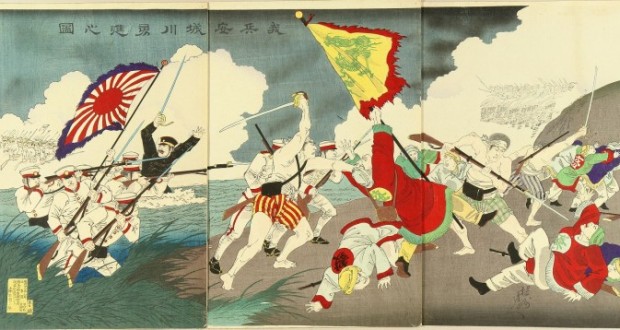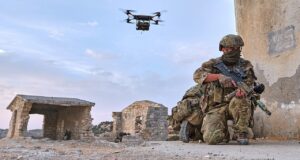by David Innerhuber – Junior Fellow
18th January 2014. Security and Defence, Issue 1, No. 1.
In 1405 A.D. the legendary Admiral Zheng He set the sails of his mighty armada for the first time. Over the following decades he went on seven journeys for the Emperors of the Ming dynasty. With up to 300 vessels and 30,000 men he came as far as Burma and India. China was the dominant naval power in the world – until Emperor Zhengtong had the entire fleet burnt down. The emperor and his advisors were of the opinion that such a vast fleet was not needed since the other nations on Earth had no other choice but to come to the ‘Middle Kingdom’ and bow to its emperor as tributaries.
Today’s communist party, however, does not count on this magnetism of the middle anymore. They increasingly project their economic, political and military power across China’s borders and their geopolitical interests become manifest everywhere in East Asia. The air defence zone in the East China Sea that also encompasses the disputed Senkaku/Diaoyu islands is just the latest step in this development that is very likely to end in minor regional conflicts or even a major hegemonic struggle with the US about dominance in the Pacific.
For years now, the Chinese government invests heavily in its navy. There are research programmes for new aircraft carrier as well as for high-velocity anti-ship missiles that would push US areas of operation from the Chinese coast far back into the Pacific. This gives Beijing some political leeway that it can use for ever new provocations such as the aforementioned air defence zone.
It is quite clear, however, that the US will remain the dominant power in the region in the foreseeable future. Their military supremacy is obvious – from a technological point of view they are still about 20 years ahead of the Chinese. Pentagon simulations show that, in case of a mobilisation, the Americans would be able to sink about 80% of Chinese vessels before they could even leave their harbour. The Chinese government knows that and this is the reason why the conflict seems manageable at first glance.
China’s claim to power, however, is just one part of the story. The other part is about revisionism and the ‘Greater East Asia Co-Prosperity Sphere’ which, in 1940, marked the climax of the Japanese Empire that had been in the making since the end of the 19th century.
The war crimes and crimes against humanity on which this empire was founded were – and still are – admitted only half-heartedly in post-war Japan and shape the relations among the nations of the region up to this day. In its wish to infuse Japan with pride and optimism, the liberal-democrat government under prime minister Shinzo Abe does not hesitate to denounce even the most tentative attempts of revisionism in Japanese school books as ‘ideologically self-tormenting view of history‘, thereby putting itself expressly into a continuity of the calamitous past.
This is about more than just some rocks in the sea
Even though they did not play a big role, the uninhabited rocky islands that the current crisis is about were also part of this story, which allows China to make them a symbol of their desire for a new geopolitical order. It is beyond controversy that Japan annexed the islands in 1895 in the course of the first Sino-Japanese war and called them Senkaku. China, however, rejects the Japanese claim that these islands were terra nullius – territory under no control of any state.
In fact, Japanese documents from the late 19th century, presented by the Taiwanese historian Han-Yi Shaw in the New York Times in 2012, refer to the islands as Chinese property. Based on these documents, Japan’s foreign minister in 1885 advised against an occupation of the islands. Chinese scientists found the earliest reference to the islands as being part of China in books from the 15th century and in 1893 Empress Cixi is said to have given the islands to a Chinese medic for the recovery of rare herbs.
Renunciation of the pacifist route of the post-war era
It is not quite clear, however, what this means from an international law point of view. In a positivist fashion, Japan argues that, unlike Taiwan, the islands were not returned to China by the 1951 Treaty of San Francisco between the United States and Japan, but instead were put under US administration together with Okinawa and returned to Japan in 1970. And that is exactly what China blames the US for: That it contravened the Declarations of Kairo 1943 and Potsdam 1945 according to which all coerced agreements were void and Japan was expected to return all occupied territories to China. Renewed interest in the islands came as late as 1969, when natural resources were discovered in their vicinity.
Japan, however, denies that there is any dispute at all, as prime minister Abe emphasised last summer. In 1978 Deng Xiaoping advocated the suspension of the island dispute until ‘wiser generations could solve it‘, but Japan did not even accept this formulation as it now says. This denial has far-reaching consequences. Abe presents the Chinese demands as an illegitimate claim to power that Japan has to oppose for the sake of the whole region.
The islands seem to be the test case for a new Asian security community for the establishment of which Abe wants to rearm Japan and correct its outdated pacifist constitution. He presents himself as the advocate of the rule of law and the freedom of the seas that must not be surrendered to pure power. But in his negligence of the past he demonstrates that for Japan, too, questions of power and national interest prevail. This became obvious in the words of Kuni Miyake, policy advisor at the Canon Institute for Global Studies in Tokyo: ‘If China insists on being a Pacific power and challenging the US-Japanese maritime hegemony, a showdown is inevitable‘.
The past must not be neglected anymore
Thus, the pre-war constellation returns, inter alia, because Japan manipulates its own past, which is not appreciated in the US. Washington does not get tired to emphasise its neutrality in the island dispute, while at the same time increasing their own presence in the Pacific and embracing Japan’s willingness to take more military responsibility. The more powerful China becomes, however, the more its new-found self-confidence collides with what it perceives as the maintenance of an imperialism that it had to endure far too long due to its own weakness.
Chinese commentators interpret the erratic installation of the air defence zone as renunciation of Deng Xiaoping’s reluctance to formulate spheres of national interest and as an attempt to force Japan to the negotiating table. According to Liu Jiangyong from the University Tsinghua in Beijing, their overlapping air defence zones require close consultation between the two countries and thus would force Japan to admit that the islands are in fact disputed territory.
Right now, Japan does not want hear about that. Since China is a communist one-party regime whereas Japan is a parliamentary democracy, the latter’s historical amnesia is hardly seen as a problem in the West. But when old and new empires collide – without any mediation – over their historical claims to power, the situation can easily escalate. There have already been several precarious incidents, at sea as well as in the air. Overly ambitious commanders on both sides can rapidly let the situation get out of control, as we have seen, for example, during the Cuban Missile Crisis. Let us all hope that history does not repeat itself that way.
David Innerhuber is contactable at:
David.Innerhuber@hscentre.org
Please cite this article as:
Innerhuber, D. (2014). ‘When old and new Empires collide: The historical roots of the Sino-Japanese Island Dispute’
Human Security Centre, Defence and Security, Issue 1, No. 1.
 Human Security Centre Human Rights and International Security Research
Human Security Centre Human Rights and International Security Research




